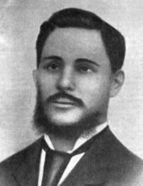

A Brazilian historian, born in 1853 in Mecejana, state of Ceará, who died in 1927 in the city of Rio de Janeiro. He completed his studies in his home province and in Pernambuco, but did not go on to university. In Fortaleza, he took part in the "Escola Popular" [ People's School ], a positivist-inspired initiative aimed at disseminating knowledge through this perspective, and began his work in literary criticism. At the age of 22, he travelled to Rio de Janeiro with letters of recommendation from influential people from his homeland, including the already renowned novelist and politician from Ceará, José de Alencar, whom he had helped to research Ceará folklore. At the Court, he worked with the bookseller and publisher Garnier and taught at a prestigious school, Externato Aquino ( Aquino Day School ). In 1879, he began to work regularly in the press, initially writing literary criticism articles for the Gazeta de Notícias and became an employee of the National Library. In this role, he collaborated on the Catálogo da Exposição de História do Brasil (Brazilian History Exhibition Catalogue) , in 1881, a monumental display of Brazilian historical documents. In recognition, he was awarded a knighthood of the Order of the Rose by the imperial government. Meanwhile, he continued his studies of languages and Brazil's history. In 1883, he applied to teach History at Colégio Pedro II [Pedro II School] , a role he secured through a contest in which he stood out for the originality of his thesis. Already fully integrated into the intellectual circles of the Court, in 1887, he was elected to the Instituto Histórico e Geográfico Brasileiro [Brazilian Historical and Geographical Institute] . Alongside his teaching work, he also devoted himself to translations, such as those of the works of Wappoeus, A terra e o homem [Earth and Man] , Selin, Geografia geral do Brasil [General Geography of Brazil] and Kirchhoff, O homem e a terra [Man and Earth] all from German, among other languages. At the same time, he dedicated himself to publishing historical texts, such as the História do Brasil [History of Brazil] by Friar Vicente do Salvador, in whose "Prolegomena" he introduced the author and work, published in 1889, the Primeira Visitação do Santo Ofício às partes do Brasil (Confissões da Bahia) [First visit of the Holy Office to Brazil (Confessions of Bahia)] published in 1922 in a limited edition, later published in 1935 by the Sociedade Capistrano de Abreu [Capistrano de Abreu Society] , and the annotations to the História Geral do Brasil [General History of Brazil] by Varnhagen, among others. In 1899, when the teaching position of Brazilian History was eliminated, he was able to devote himself entirely to historical research. His favourite subjects were the discovery of Brazil, territorial expansion, the formation of social groups and communications between the different captaincies, as well as ethnographic research, including on indigenous languages.
This work is financed by national funds through FCT - Foundation for Science and Technology, I.P, in the scope of the projects UIDB/04311/2020 and UIDP/04311/2020.
